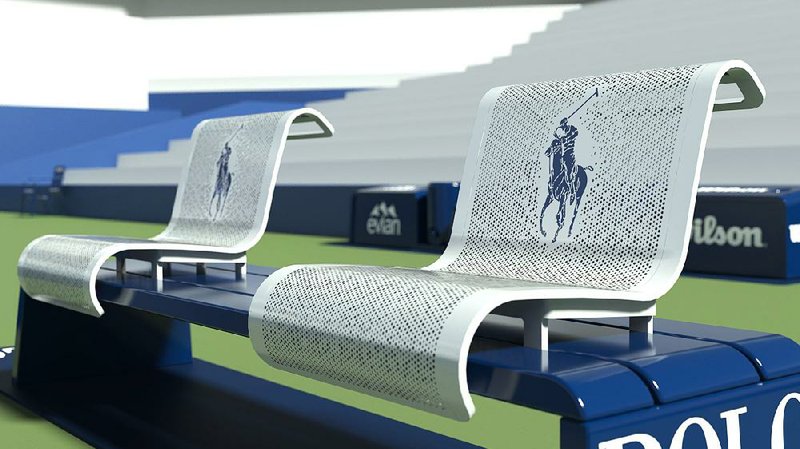Watching the 2018 U.S. Open, my husband fixated on the action, while I turned my attention to the sidelines: the notable spectators, their attire, and, was that new courtside furniture? It all looked so much nicer than I remembered.
"Are those new chairs?" I ask DC.
"Maybe," he shrugs, then adds with a laugh, "leave it to you to notice the furniture."
The answer came in my inbox the next day, an email from Michael Graves Architecture & Design announcing the firm's role in creating a redesigned "courtscape" to celebrate the U.S. Open's 50th anniversary.
I knew it! I celebrate a small private victory, then soak up the details.
Full confession: I am a Michael Graves fan. Before the legendary architect and designer died in 2015 at 80, I'd interviewed him twice -- once in 2003 for my first home column, "What is good design anyway?" and again in 2011 when he launched a line of home products for Target.
I've long admired his human touch.
"Whether creating a city plaza or a tea kettle, what Michael cared most about was how humans interacted with everything," said Donald Strum, MGA&D principal and head of product design who worked alongside the architect for more than 30 years. "His focus was to make that experience as perfect as it could be."
Strum led the U.S. Open court furniture project, and played out his mentor's philosophy on center court -- with grand-slam strokes.
I called Strum to get the whole scoop, from concept to court.
After beating out several design firms, Strum learned last December that his firm had won the commission. "We were excited, then we realized we had to pull it all off in just nine months," he said. Not to add to the pressure, but the world would be watching.
Time to rally.
Ever since the kickoff meeting last January with the United States Tennis Association in New York, home of the U.S. Open, it was a full court press, he said.
In just nine months, the design team created an iconic look for the event's 50th anniversary, which included a new umpire tower, modernized player and line umpire chairs, and a cooler corral, to reduce visual clutter, improve the sight lines and better organize the players' drinks, snacks and ball bags. All the new furniture was in place when the matches began Aug. 27.
"It was a high-pressure, high-profile project, the kind Michael lived for," Strum said.
Creativity under pressure always gets my attention, so I grilled Strum about the creative design process and how to create something from nothing.
When creating something from scratch, where do you start?
"With a good understanding," Strum said. "The USTA asked us to submit a sketch up front, a hint of what the new look could be, but we declined. We didn't know enough. If we were to develop a sketch, we'd be doing it blindly. Who were we to say this is what tennis furniture in New York should look like? Based on what?"
Instead they started the design process by talking to everyone involved: players, officials, judges, line umpires, fans and sponsors. They asked what was working and what wasn't. They learned, for instance, that the cotton canvas director chairs that the players and line umpires had been sitting on all these years held onto the sweat and the wet. Ick. The new ones are made of lightweight aluminum. They are perforated so they vent, and are painted with reflective paint so they stay cool.
They found that the tall umpire stand, which hadn't been updated since 1997, was treacherous to climb, and didn't accommodate today's technology. The new ones do, and angle up to make access easier.
They also learned that fans in some of the most expensive front row seats had drink coolers blocking their views. Not anymore.
How did you go from problem defined to problem solved?
"We turned to context. Every design must be site specific. So we looked at what this tournament represented and to New York -- its skyscrapers, Central Park, the fire escapes on the backs of buildings. Then we began sketching. We produced hundreds of sketches."
The players' S-shaped chairs rest on forms that echo benches in Central Park. The umpire tower mimics the city's skyscrapers, and tapers as it rises to appear taller.
After you've drawn hundreds of sketches, how do you know when you've got it?
"You go through a series of sketches, and keep getting closer. It's a reductive process. Then you get to a design that works, but just feels OK. You don't settle. You come back later and re-engage, until you have a sketch that you realize checks all the boxes. You know it when you see it. It makes you smile."
What does pressure add to the mix?
"I view it as a positive. I am all for pressure and deadlines. Otherwise you would keep ruminating and not focusing. When you're forced to concentrate, something good will come of it."
What do you wish more people understood about design?
I learned from Michael to always ask why things are and aren't right. If something's not right, don't put up with it. Make a change.
What would Michael Graves say if he saw this courtside furniture?
"He would have given us a huge bravo."
Game. Set. Match.
Syndicated columnist Marni Jameson is the author of three home and lifestyle books, including Downsizing the Family Home: What to Save, What to Let Go (Sterling Publishing).
HomeStyle on 09/15/2018
